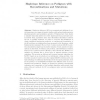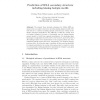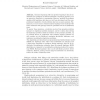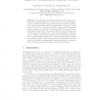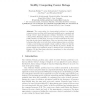114
click to vote
WABI
2010
Springer
14 years 10 months ago
2010
Springer
Abstract. A recursive algorithm by Aho, Sagiv, Szymanski, and Ullman [1] forms the basis for many modern rooted supertree methods employed in Phylogenetics. However, as observed by...
134
click to vote
WABI
2010
Springer
14 years 11 months ago
2010
Springer
Abstract. Haplotype Inference (HI) is a computational challenge of crucial importance in a range of genetic studies, such as functional genomics, pharmacogenetics and population ge...
115
Voted
WABI
2010
Springer
14 years 11 months ago
2010
Springer
Although many supertree methods have been developed in the last few decades, none has been shown to produce more accurate trees than the popular Matrix Representation with Parsimon...
179
Voted
WABI
2010
Springer
14 years 11 months ago
2010
Springer
Abstract. We present three heuristic strategies for folding RNA sequences into secondary structures including kissing hairpin motifs. The new idea is to construct a kissing hairpin...
121
click to vote
WABI
2010
Springer
14 years 11 months ago
2010
Springer
Abstract. Genome sequencing will soon produce haplotype data for individuals. For pedigrees of related individuals, sequencing appears to be an attractive alternative to genotyping...
139
click to vote
WABI
2010
Springer
14 years 11 months ago
2010
Springer
The double cut and join (DCJ) operation, introduced by Yancopoulos, Attie and Friedberg in 2005, allows one to represent most rearrangement events in genomes. However, a DCJ cannot...
130
Voted
WABI
2010
Springer
14 years 11 months ago
2010
Springer
In this paper we present a novel expectation-maximization algorithm for inference of alternative splicing isoform frequencies from high-throughput transcriptome sequencing (RNA-Seq...
126
Voted
WABI
2010
Springer
14 years 11 months ago
2010
Springer
Abstract. The orientation of physical networks is a prime task in deciphering the signaling-regulatory circuitry of the cell. One manifestation of this computational task is as a m...
123
Voted
WABI
2010
Springer
14 years 11 months ago
2010
Springer
Background: Although many RNA molecules contain pseudoknots, computational prediction of pseudoknotted RNA structure is still in its infancy due to high running time and space con...
123
click to vote
WABI
2010
Springer
14 years 11 months ago
2010
Springer
The center string (or closest string) problem is a classical computer science problem with important applications in computational biology. Given k input strings and a distance thr...

